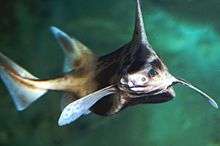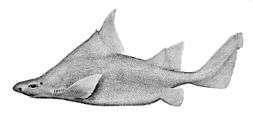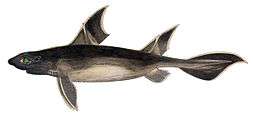Oxynotus
Oxynotus is a genus of sharks in the order Squaliformes, commonly known as the rough sharks. It is the only extant genus in the family Oxynotidae. They live in deep waters in the Atlantic and western Pacific Oceans.
| Oxynotus | |
|---|---|
 | |
| Caribbean roughshark, Oxynotus caribbaeus | |
| Scientific classification | |
| Kingdom: | Animalia |
| Phylum: | Chordata |
| Class: | Chondrichthyes |
| Order: | Squaliformes |
| Family: | Oxynotidae T. N. Gill, 1912 |
| Genus: | Oxynotus Rafinesque, 1810 |
| Type species | |
| Oxynotus centrina Rafinesque, 1810 | |

Prickly dogfish, Oxynotus bruniensis

Angular roughshark, Oxynotus centrina
Rough sharks are small to medium in size, ranging from 49 to 150 cm (1.61 to 4.92 ft) in adult body length, depending on species. Their bodies are compressed, giving them a triangular cross-section. They have two large dorsal fins, each with a sharp spine, and with the first fin placed far forward above the head. Even more so than their relatives, the dogfishes, they have rough and prickly skin. Unusually among sharks, they also possess a luminous organ.[2]
Species
- Oxynotus bruniensis Ogilby, 1893 (prickly dogfish)
- Oxynotus caribbaeus Cervigón, 1961 (Caribbean roughshark)
- Oxynotus centrina Linnaeus, 1758 (angular roughshark)
- Oxynotus japonicus Ka. Yano & Murofushi, 1985 (Japanese roughshark)
- Oxynotus paradoxus Frade, 1929 (sailfin roughshark)
gollark: They're definitely... writing Rust code of some sort?
gollark: I can't tell.
gollark: They forgot hydrogen!
gollark: ???
gollark: Umnikos == helloboi confirmed?
See also
- List of prehistoric cartilaginous fish
References
- Sepkoski, Jack (2002). "A compendium of fossil marine animal genera (Chondrichthyes entry)". Bulletins of American Paleontology. 364: 560. Archived from the original on 2012-05-10. Retrieved 2008-01-09.
- Froese, Rainer, and Daniel Pauly, eds. (2009). "Oxynotidae" in FishBase. January 2009 version.
| Taxon identifiers |
|---|
This article is issued from Wikipedia. The text is licensed under Creative Commons - Attribution - Sharealike. Additional terms may apply for the media files.